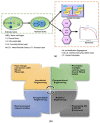Recent Issues and Configuration Factors in Perovskite-Silicon Tandem Solar Cells towards Large Scaling Production
- PMID: 34947535
- PMCID: PMC8708322
- DOI: 10.3390/nano11123186
Recent Issues and Configuration Factors in Perovskite-Silicon Tandem Solar Cells towards Large Scaling Production
Abstract
The unprecedented development of perovskite-silicon (PSC-Si) tandem solar cells in the last five years has been hindered by several challenges towards industrialization, which require further research. The combination of the low cost of perovskite and legacy silicon solar cells serve as primary drivers for PSC-Si tandem solar cell improvement. For the perovskite top-cell, the utmost concern reported in the literature is perovskite instability. Hence, proposed physical loss mechanisms for intrinsic and extrinsic instability as triggering mechanisms for hysteresis, ion segregation, and trap states, along with the latest proposed mitigation strategies in terms of stability engineering, are discussed. The silicon bottom cell, being a mature technology, is currently facing bottleneck challenges to achieve power conversion efficiencies (PCE) greater than 26.7%, which requires more understanding in the context of light management and passivation technologies. Finally, for large-scale industrialization of the PSC-Si tandem solar cell, the promising silicon wafer thinning, and large-scale film deposition technologies could cause a shift and align with a more affordable and flexible roll-to-roll PSC-Si technology. Therefore, this review aims to provide deliberate guidance on critical fundamental issues and configuration factors in current PSC-Si tandem technologies towards large-scale industrialization. to meet the 2031 PSC-Si Tandem road maps market target.
Keywords: perovskite-silicon; roll-to-roll; solar cell; stability; tandem.
Conflict of interest statement
The authors declare no conflict of interest.
Figures








References
-
- Covid-19 and the Clean Energy Challenges and Opportunities|Standard Chartered. [(accessed on 16 June 2020)]. Available online: https://www.sc.com/en/trade-beyond-borders/covid-19-clean-energy-challen...
-
- Global Renewable Energy Market and the Affects of COVID-19 to 2021—The Solar Segment Dominates the Renewable Energy Sector. [(accessed on 16 June 2020)]. Available online: https://www.globenewswire.com/news-release/2020/05/05/2027415/0/en/Globa....
-
- Price-Efficiency Relationship for Photovoltaic Systems on a Global Basis. [(accessed on 13 June 2020)]. Available online: https://www.hindawi.com/journals/ijp/2015/256101/
-
- Boriskina S.V., Chen G. Exceeding the solar cell Shockley-Queisser limit via thermal up-conversion of low-energy photons. Opt. Commun. 2014;314:71–78. doi: 10.1016/j.optcom.2013.10.042. - DOI
-
- Green M.A., Hishikawa Y., Dunlop E.D., Levi D.H., Hohl-Ebinger J., Ho-Baillie A.W.Y. Solar cell efficiency tables (version 52) Prog. Photovolt. Res. Appl. 2018;26:427–436. doi: 10.1002/pip.3040. - DOI
Publication types
Grants and funding
LinkOut - more resources
Full Text Sources

